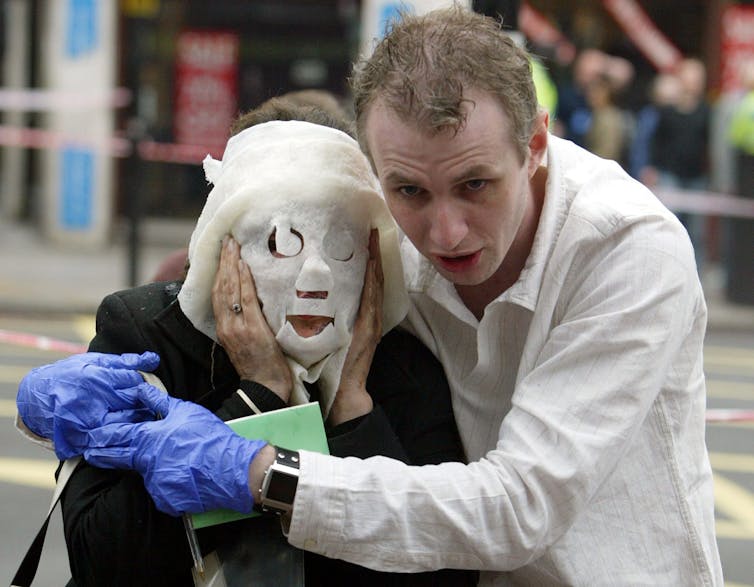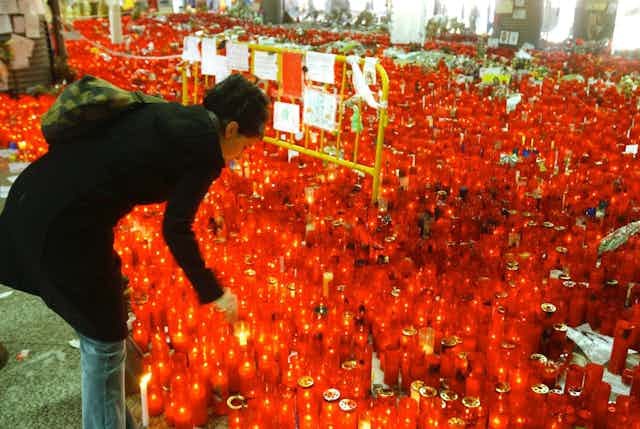Acts of terrorism are harrowing and can cause extensive damage and tragic deaths, and they have been occurring with alarming frequency over the last decade.
On Sept. 11, 2001, al-Qaida executed a series of co-ordinated attacks against the United States, killing close to 3,000 people and injuring over 6,000. On March 11, 2004, an extremist Islamist group bombed four commuter trains in Madrid during morning rush hour, killing 191 people and injuring another 2,000. On July 7, 2005, Islamist suicide bombers attacked London’s public transport system, killing 52 people and injuring more than 700 others. The list goes on.
Scholars, governments and analysts have spent a lot of time exploring individual motivations of terrorists. However, terrorist activities are typically performed by groups, not isolated individuals. Examining the role of team dynamics in terrorist activities can elucidate how terrorist teams radicalize, organize and make decisions.
Read more: Why the media needs to be more responsible for how it links Islam and Islamist terrorism
There is a common misconception in the West that leaders of al-Qaida and, more recently, Daesh (ISIS) are recruiting and brainwashing people into giving up their lives to establish a new political order. This is an incorrect model that has been vastly exaggerated in the media, based on a western understanding of leadership.
My recent research with Guihyun Park of Singapore Management University seeks to provide a better understanding of what motivates terrorist teams and how they make their decisions. How do terrorist teams combine their local identity with a global mission? How do they organize themselves and co-ordinate attacks in the presence of this fluidity, yet maintain a high level of cohesiveness?
Islamist terrorist teams
Conceptualizing terrorist teams as loosely coupled structures can help us answer these questions. The term loosely coupled systems refers to structures in which the entire system represents a holistic unit, while still preserving the unique identity of the components that make up the entire system.
In other words, team members enjoy a great deal of autonomy, without losing sight of the objectives of the team as a whole. Terrorist teams as systems demonstrate both loose vertical coupling — self-management — and loose horizontal coupling — little interdependence between team members.

Loosely coupled systems bear a number of advantages: they allow individuals to retain their own identity and self-determination; they are highly effective at sensing and responding to changes or opportunities in the environment; and they are better able to respond to breakdowns in the subcomponents of the system.
Our research focused on extremist Islamist terrorist attacks from the last 15 years and built on previous work conducted with researcher John R. Hollenbeck. Drawing on the theories of American organizational scholar Karl Weick, we looked at the literature on group behaviour and team decision-making and leveraged the theories of “loose coupling” in terrorist teams.
Random leadership
An emergent rather than top-down leadership structure is a defining structural feature of extremist Islamist terrorist teams. Scott Atran and Marc Sageman’s analysis of the March 11, 2004, Madrid train bombings which killed 191 people and injured another 2,000 shows how random the leadership structure was among the affiliated terrorist network.
The individuals that gravitated toward a leadership role in the network simply emerged as being the most effective in facilitating the logistics and communication demands of the group. The social system determines the objectives and missions, not the individual leaders.
The strength of terrorist teams does not reside in their leaders, but rather in their complexity. Despite a high degree of familiarity among some team members, connections among the larger network are typically quite loose.
In the case of the terror attacks on four commuter trains in Madrid, a diverse group of individuals was ultimately involved, from the Islamist terrorist team that carried out the attacks and its wider social support network, to petty criminals, Spanish miners and two police informants.
Implications for counterterrorism efforts
The fluid nature of terrorists teams, together with their lack of a traditional leader, make their activities hard to combat. Loosely coupled terrorist teams have a tremendous ability to adapt to local circumstances.
For example, prior to the 2004 Madrid train bombings, Spanish authorities knew the terrorist group involved had been discussing and praising extremist operations worldwide. They also knew the same group had voiced their intent to conduct their own attack on Spanish soil. However, because no ties to al-Qaida could be established, none of the team members were brought in and detained. This suggests that counterterrorism efforts should focus less on external ties to terrorist organizations and more on the actual operations of the terrorist teams.
Leveraging the advantages of loose coupling
The ways in which terrorist teams organized themselves represent one of the best examples we’ve seen of loose coupling. Many of these same principles can be applied to organizations seeking to be more agile and innovative.
An organization, for instance, could assemble a team that has no formal leader. Team members would step up, but then also step back when they may not be the best individual to lead the group in a particular initiative. Establishing fluid boundaries, which let in resources and information from outside the group, could also prove effective, as well as bringing together people from different parts of the organization.
Thankfully, the majority of terrorist teams fail. They either disband before they launch an attack, are discovered during preparations, or the attack itself is not successful. That said, violent group actions have had a profound effect on our world over the last 15 years. Thus, their impact cannot be evaluated by looking at the successes or failures of individual teams, but rather the potential success of the combined attacks.


